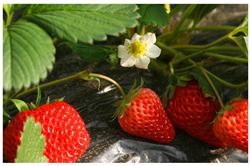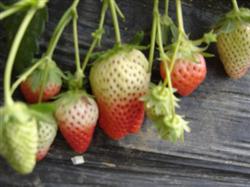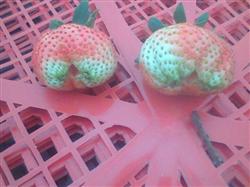Cultivation techniques of Strawberry in protected Field

Strawberry is a kind of berry plant widely cultivated all over the world. It is rich in nutrition, juicy fruit, sweet and sour delicious, it is easy to breed, benefit quickly, take certain measures, planted in the same year can bear fruit. Strawberries are like cucumbers, tomatoes and other vegetables, strawberry varieties in different ripening periods can be planted reasonably or cultivated with different protective measures, which can make strawberry fruits mature in different periods and prolong the time of fresh fruit supply. moreover, it can also increase the yield of strawberries by more than 30%, and the highest increase is more than double. Moreover, the cultivation of strawberries in protected areas will make more economical use of land, improve land labor productivity, and have considerable economic and social benefits. 1. Arrangement of stubble the ripening period of different strawberry varieties is different, and the arrangement of strawberry production stubble in solar greenhouse is also different. Planting one-season varieties, stubble arrangement for the previous crop strawberry and next crop vegetables, vegetable varieties such as tomatoes, cucumbers and beans are better. In Dandong area, strawberries are generally planted from late September to early October, tomatoes are planted on strawberry ridges in mid-February, strawberries begin to ripen in mid-March, strawberry harvest ends in mid-April, tomatoes begin to appear on the market in late May, and land leisure lasts for 2 months. After artificial fertilization, the production cycle of the following year will be carried out. Planting multi-season mature strawberry varieties generally has a production cycle every year, spanning two years. Spanish strawberry Ducla varieties are planted from the end of September to the beginning of October, mature in early February, and end at the end of June. Land fallow for two months, artificial fertility, and then carry on the next year's production cycle. Second, variety selection 1, star varieties: American varieties, plant growth is more exuberant, opening, weak branching power, larger leaves. The average unit weight of the first order fruit is 23 grams. It is an one-season variety with strong disease resistance and high yield, with a yield of 1500Mu / mu. 2. Hani: American variety with strong plant growth, medium branches and large leaves. The average weight of the first order fruit is 25.2 grams. The pulp is slightly hard and fine, which is suitable for transportation and processing. The variety has good disease resistance and high yield, with a general yield of about 2000 kg per mu. 3. Gerrera: Dutch variety, the plant is erect, compact, the branching force is medium, and the leaf is oval. The average weight of the first order fruit is 24 grams. The fruit is red, hard and the pith is empty. The plant is resistant to cold and disease. It is an one-season variety with high yield, with a yield of 2000 kg per mu. 4. Baojiao Zaosheng: Japanese variety, with open plant growth and medium branching ability. The average weight of the first order fruit is 17.2 grams, the skin is thin, it is not resistant to storage and transportation, the flavor is sweet, the quality is excellent, and it is an one-season variety. The dormant period is short, so it is suitable for cultivation in open field and protected field, with a yield of 1000 Mu and 1500 kg per mu. 5. Chunxiang: Japanese variety, the plant is erect, the branching power is medium, the leaf is larger, the average fruit weight of the first order fruit is 17.8 grams, the fruit juice is red, the taste is sweet and the quality is excellent. It is an one-season variety with a short dormancy period and is suitable for cultivation in protected areas, with a general yield of 1500 kg per mu. 6. Changhong: a Chinese variety with medium plant growth and open plant state. The average weight of the first order fruit is 18 grams. This variety is cold-resistant and disease-resistant, has high yield and concentrated fruit ripening in each stubble. It is an ideal four-season variety suitable for commercial production, with a yield of 1500Mu and 1800kg per mu. 7. TODLA: Spanish variety with erect plants and medium fecundity. The average weight of a first-order fruit is 33 grams. The plant has strong stress resistance, disease resistance and high yield. It is the shortest dormant period among strawberry varieties at present, and it matures earliest in protected cultivation, and can be harvested in January in general. It is a multi-season variety. Greenhouse cultivation can produce inflorescences for 5 times and produce fruit for many times, which lasts for 3 months. The suitable conditions are 4 months. Generally, the yield per mu is 3000 kg, and the highest yield per mu is 5000 kg. 8. Kart No. 1: Spanish variety, the plant is open and the plant is large. The growth potential is strong and the fecundity is weak. The average weight of the first order fruit is 30 grams. The taste is delicate, fragrant, sweet and sour, and the quality is excellent. The plant has strong resistance and long dormancy period, so it is suitable for cultivation in open field and cold shed, with a yield of 2500 Mu and 3000 kg per mu. 3. Seedling cultivation in strawberry production, the seedling formed by stolon is separated from the mother plant to form new strawberry seedlings to cultivate strawberry seedlings. Mother plant management should focus on saving nutrition in order to promote the production of stolons and the cultivation of healthy seedlings. After removing the inflorescence of the mother plant, the inflorescence produced after the survival of the mother plant should be removed in time to accumulate nutrition and improve the reproduction rate of seedlings. When the mother plant produces the stolon, it is necessary to draw and press the stolon in time, and guide the stolon to the bed where there is a growth position. when the stolon produces young leaves, the front end presses the ground with a small amount of fine soil to expose the growing point to promote root growth. After entering August, when the grape stolon seedlings are all over the bed, it is necessary to remove the excess stolons in time and control the growth number. Generally, 6 stolon seedlings are retained for each mother plant, and the excess stolons are removed before landing, and strong seedlings can be cultivated from September to October. 4. Planting 1. Soil preparation: a week before planting, the soil was prepared by applying high-quality farm manure of about 4000tel 5000 kg per mu, with a depth of 30cm, leveling and raking finely. According to the cultivation plot, the bed was ridged to make a bed. The general bed height was 1015cm, the ridge bed width was 60ly70cm, the ridge bed spacing was 20tel 30cm, and the ridge bed orientation was consistent with the greenhouse orientation. 2. Planting time the planting time of strawberry cultivated in solar greenhouse is determined by seedlings and local temperature conditions. generally, seedlings can be planted before flower bud differentiation or after flower tooth formation. However, before the low temperature comes, newly planted strawberries must be able to return to normal development. It is better to plant in Dandong in mid-September and October, and then in mid-July to late July before flower bud differentiation of strawberry. 3. Planting density should be wide or narrow row (or double row) planting. Usually, the distance between two rows on the ridge bed is 35m ~ 45cm, the distance between holes is 25m ~ 30cm, 4000 holes to 4500 holes per mu, and 3 trees are planted in each hole. If a single plant is planted, the distance between plants is 13,000cm, and 10000 seedlings are used per mu. 4. The planting method first covers the plastic film on the ridge bed for four weeks, and then punches the plastic film according to the planting density on the ridge bed, planing holes, and when planting seedlings, the back side of the seedling should be turned outward, so that the inflorescence is planted on both sides of the bed. Then stretch the roots of the seedlings, cultivate fine soil, plant seedlings, and the base of the new stem of the seedlings should be flush with the bed. It can also be planted directly on the ridge bed without plastic film mulching. 5. Management after planting 1. Soil management after strawberry planting, the main management content is soil moisture. Due to the high indoor temperature, large soil water transpiration coefficient and high air temperature, the irrigation time is generally carried out in the evening. Irrigation in the greenhouse should be thoroughly watered at once, not frequently watered or sprinkled, so as to mediate the excessive temperature of the air. After strawberry planting, you can find weeds and eradicate them in time. 2. Plant management after strawberry planting survived, the management of strawberry plants mainly includes three contents: the first is to remove stolons. Remove the stolon extracted from the plant in time, remove it as you see it, and concentrate it out for outdoor destruction. The second is to remove withered leaves and weak buds. After strawberry survival, the leaves continue to age, photosynthesis is weakened, and diseased leaves are produced, so the old yellow leaves, diseased leaves and weak lateral buds on the plant should be continuously removed in the growing season, in order to save nutrition and concentrate nutrition to provide results. The third is to remove the buds. Remove excess buds before blooming. Large fruit varieties retain 1-and 2-order buds, while medium-and small-sized fruit varieties retain 1 -, 2-and 3-order buds. 3. Temperature control solar greenhouse increases room temperature by covering plastic, and the time of film mulching varies from place to place due to different climatic conditions. It is appropriate to buckle the film before freezing in Dandong area in the middle of November. The solar greenhouse heats up rapidly after film mulching, and the initial maximum temperature should not exceed 25 ℃. When the temperature is higher, the tuyere should be opened to cool down. The temperature decreases at night, and the lowest temperature should be kept above 5 ℃. When the temperature continues to drop, measures such as covering paper quilt or straw curtain on plastic film should be taken. In case of low temperature in a special year, a brick fire wall can be built on the back wall of the greenhouse and the furnace can be heated. After strawberry growth, the temperature control index in the greenhouse was as follows: the night temperature was more than 2 ℃, the day temperature was less than 30 ℃, the night temperature was more than 7 ℃ during flowering, and the day temperature was 20 ℃. 4. Although strawberries are self-pollinated and bear fruit during flowering, it is disadvantageous to strawberry pollination and fertilization due to many factors, such as large air temperature, large temperature change, small ventilation, few insects and so on. If there is no auxiliary pollination, the fruit will be smaller, the abnormal fruit will increase, the fruit size will increase, the fruit shape will be neat, and the yield will increase obviously. There are two ways to assist pollination of strawberry in greenhouse: one is that bees are pollinated by insects in greenhouse, which has the characteristics of labor saving and uniform pollination. Generally, two boxes of bees can be put in each mu of greenhouse. The second is to teach manually, with a brush or cigarette paper head. Sixth, harvest and packaging, transportation and marketing harvest: about 30 days after flowering, when the fruit color turns red, the berries are ripe, and the stalks are picked off vigorously during picking, picking every 2 days, and the ripe fruits should be picked clean each time. Pick and handle gently when harvesting, and remove malformed fruits at any time. The disease, insect fruit will be graded packaging. Packaging: choose a plastic (cardboard or veneer) box with a length of 50 cm, a width of 30 cm and a height of 15 cm (cardboard or veneer). The box is embedded with soft paper or plastic foam, and the fruit is gently placed in the box and arranged in the same direction, so that the upper stalk is between the lower fruit. Large fruit with 5 layers, small fruit with 7 layers, quantitative cover, label, origin, variety, grade and quantity. Transport: put grass curtains on the carriages with refrigerated trucks or covered trucks, close the fruit boxes and discharge them on one layer, cover the paper on the top, then discharge the second layer horizontally, pack them to the 5th floor, and cover the top fruit boxes with anti-cusp cover and seal the car. Storage: temporary storage should be ventilated, cool and tidy. Under the condition of 3mur4 ℃, it can be stored for 2murine for 3 days. Quick-freeze and refrigerate, select the fruit with neat shape, wash the sepals last year with clean water, then disinfect them with 2% potassium permanganate solution, then rinse with clean water, drain and put into plastic boxes (bags), each box is packed with 5 ℃ 10 kg, put into the quick-freezing room in 25 ℃-30 ℃ freezer for 5 ℃ for 7 hours, and then put into-18 ℃ freezer.
- Prev

Field management should be strengthened after strawberry harvest.
After strawberry berry harvest, the plant entered the vigorous growth stage, a large number of stolons occurred, new stem branches accelerated, and new young plants formed, which was the second peak period of vegetative growth in the whole year. Subsequently, as the temperature gradually increased, growth began to slow down, around the beginning of autumn, flower buds began to differentiate and then transferred to reproductive longevity.
- Next

How to prevent abnormal fruit in greenhouse strawberries
Greenhouse cultivation is a good way to increase strawberry yield and income. However, due to the strong technical nature of greenhouse cultivation, especially in winter and early spring, in the case of low temperature, weak light and changeable climate, if the management is improper, it often bears more thin, fat, curved, flat fruit, uneven fruit surface.
Related
- Moge, come on! The staff of the peasant association in the producing area of cantaloupe were frightened when the crowd gathered.
- Causes and Solutions of low Fruit setting rate of Apple
- Symptoms and control measures of passion fruit virus disease
- Fruit growing lesson: how do apple orchards keep high yields?
- Can you build orchards in the mountains? What are the pros and cons?
- How to manage the coloring period of Crisson grape?
- This paper introduces the processing technology of two kinds of fig products.
- How much is a month for retired teachers in rural areas by 2020?
- How can strawberry planting increase sugar content? We should pay attention to management in many aspects.
- What are the cultivation techniques on how to improve the yield of golden fruit?

